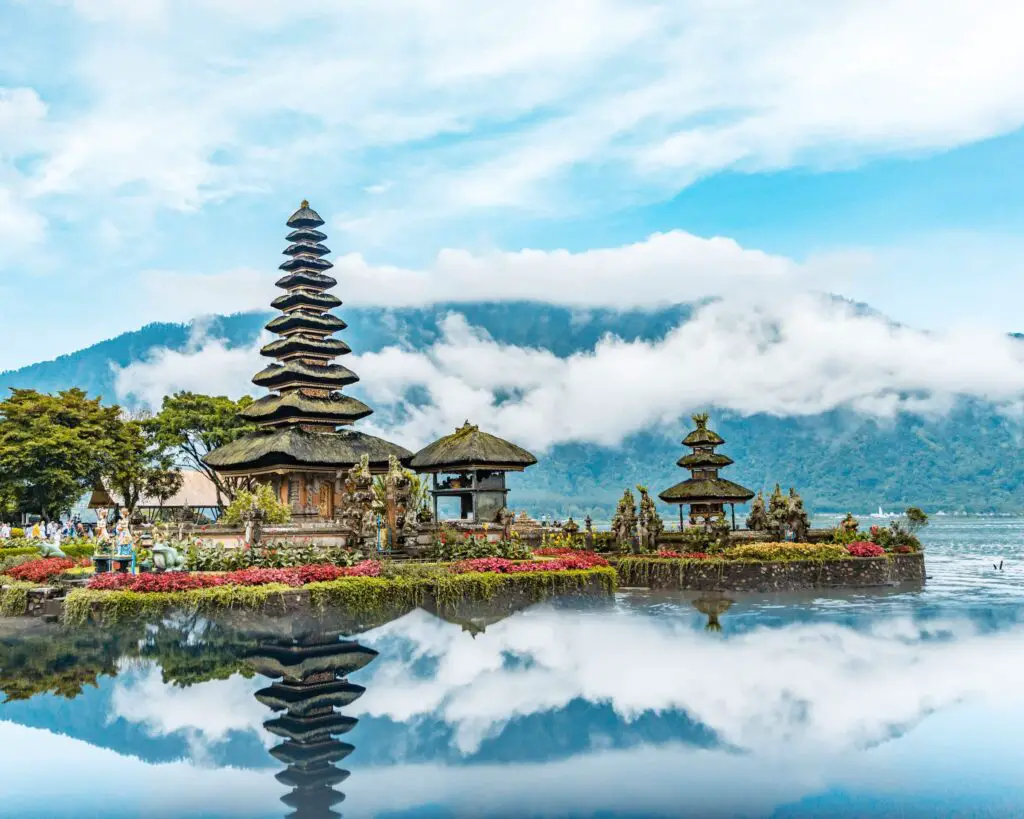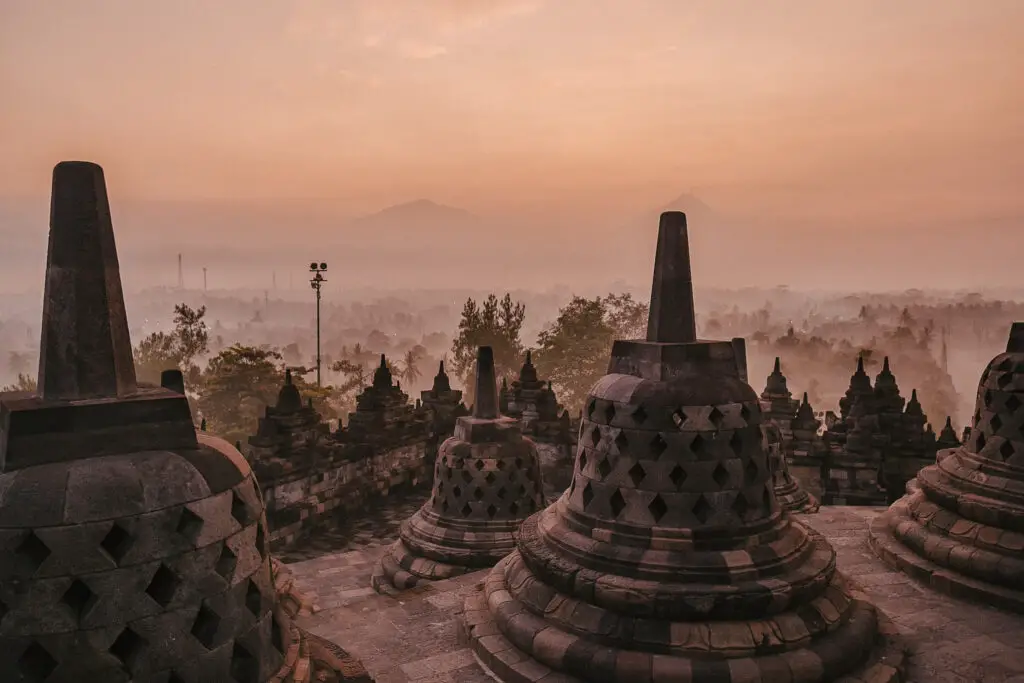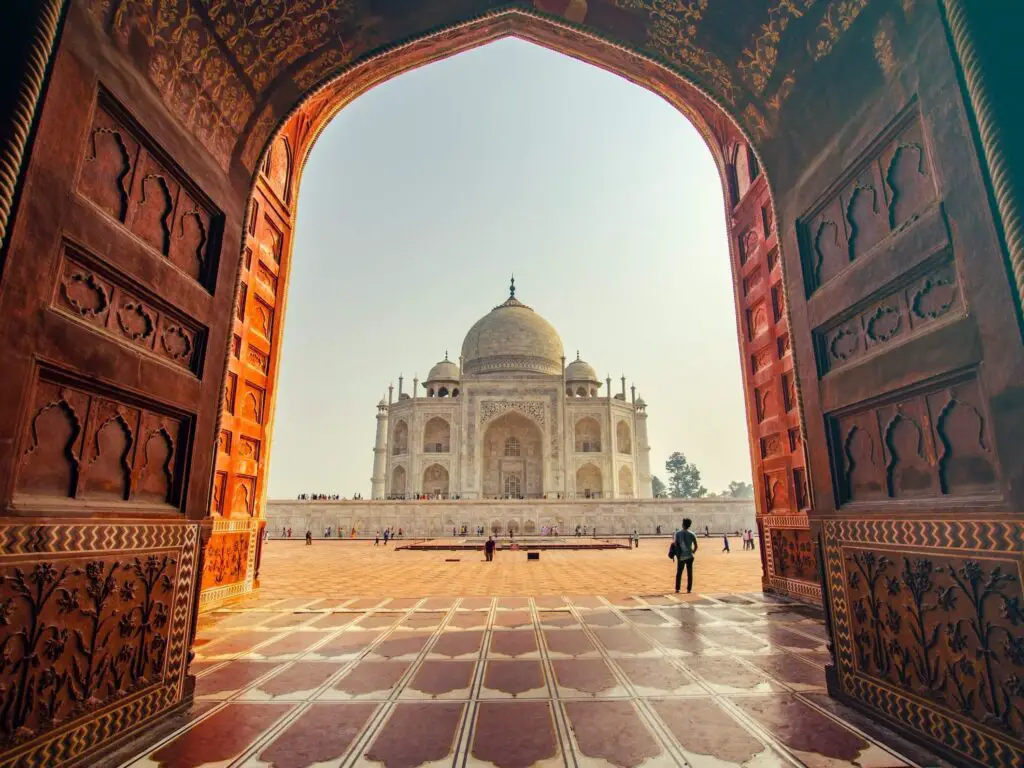7 Days in Bali Itinerary for the Ultimate Island Adventure
Are you planning 7 days in Bali itinerary and wondering how to make the most of your time on the island?
Look no further!
Our guide will take you through seven days Bali itinerary that covers the best of Bali with some hidden gems thrown in. We explored ancient temples, went on an airplane hunt around the island, and visited the most revered temple in Bali, Pura Besakih.
Bali has always been close to our hearts and this trip remains our most unforgettable journey. By the end of our 7 days in Bali, we were exhausted. But, we were left with memories that will last us a lifetime.
With breathtaking beauty and stunning landscapes coupled with rich cultural heritage, it isn’t surprising that this island paradise has captured the hearts of travelers from across the world.
This island will leave you spellbound! And, like us, you may not want to leave. So, sit back, relax, and follow us as we embark on our journey across Bali.
Disclaimer: This post contains my affiliate links which may earn me a commission if you click on them, at no extra cost. Thank you for reading and supporting my blog!
Get an easy start to your holidays in Bali with a private Bali round-trip airport transfer with a meet-and-greet service. The professional drivers assist with your luggage and there is no need to worry if your flight is delayed as your assigned driver will wait, without extra charges.
Whether you are a first-time visitor or a regular to Bali, white water rafting is the best way to spend your day. Jump in the cool waters and explore hidden cave waterfalls while learning about the native flora and fauna of Bali.
Soak in the stunning sunset view while watching the lively Kecak dance performance at Uluwatu before heading for a scrumptious dinner at Jimbaran Bay. This private tour includes hotel pick-up and drop-off, an English-speaking guide, and entrance tickets.
Visit the island of Nusa Dua with this one day all inclusive tour with hotel pick-up and drop-off, an Indonesian lunch, and an English-speaking Guide. Explore Nusa Penida’s highlights such as Angel’s Billabong, Klingkling Beach, and Crystal Bay.
Dive and swim at Bali’s East Coast which is famous for its snorkeling at the Blue Lagoon. Once underwater, enjoy the beautiful and vibrant colors of the coral reefs and look out for reef sharks, sea turtles, lionfish, and squid. Enjoy hassle-free private transfers to/from your airport.
Take a private Bali Instagram Tour of the most insta-worthy spots on the island. This tour includes a WiFi-enabled vehicle which means that you can post as you go. Visit the magical Lempuyang Temple and end your trip at the jungle swing.
Where is Bali?
The Island of the Gods, Bali is a diverse island in Indonesia. The island of Bali is known for its unique blend of culture, stunning scenery, and tourist sites. It is not surprising that it continues to attract millions of tourists every year.
Lying between Java and Lombok is Bali. It is a relatively small island and is home to a variety of landscapes. From white sandy beaches to black sand beaches, rocky coasts, and volcanic mountains amidst lush rice paddies, Bali is heaven on earth.
Bali’s tropical climate adds to its popularity. With two distinct seasons, the island is warm and humid all year round. While the wet season is from October to March, the dry season is from April to September which is also the best time to visit Bali.
What makes Bali stand out among the other islands in Indonesia is the unique culture of Bali’s Hinduism that blends ancient Hinduism with local customs. The people are spiritual and you will always see offerings everywhere you go.
Bali is a unique and diverse destination that offers something for everyone. Bali has it all, whether you are interested in culture, nature, or adventure. The island’s geography, climate, and culture make the island a must-visit destination for anyone traveling to Indonesia.
Read more:
- A Beautiful Bali Itinerary 5 Days 4 Nights
- 3 Days in Yogyakarta: How To Make the Most Out of Your Trip
- 3 Days in Bali Itinerary: Your Guide to the Best Sights of the Island!
- Hidden Gems In Bali: Top 7 You Now Know!
History
The earliest known inscription of the name Bali is in the Blanjong Pillar inscription where Walidwipa (“Bali Dwipa”) which means “Bali Island” is mentioned. This inscription was during the time of Sri Kesari Warmadewa when the Subak irrigation method was developed.
From the 13th to the 16th century, Bali was part of the Majapahit Empire that brought Hinduism to Bali. Bali’s Hinduism is unique in that it blends Hinduism, Buddhism, and animism in its daily life. This ancient tradition is preserved in its temples, art, and architecture.
By the 16th century, the Majapahit Empire declined and Bali was conquered by Muslim armies who brought Islam to the island. The Balinese people preserved their culture and Bali remained a predominantly Hindu island, despite the arrival of Islam.
The Dutch took over Bali by the 19th century when the Western education system, modern infrastructure, and Christianity was brought to Bali. Bali became part of the Republic of Indonesia after Indonesia declared its independence in 1945.
The island continues to capture the hearts of millions who visit every year. With a rich history and ancient past, Bali has something for everyone, whether it is simply to relax on its many beaches or explore its history.
Read more:
- Top 7 Hidden Gems In Bali
- A Beautiful Bali Itinerary 5 Days 4 Nights
- 3 Days in Yogyakarta: How to Get the Most Out of Your Trip
Visa Requirements
The length of stay, your nationality, and your purpose of stay would determine if you require a visa to Indonesia. The common types of visas available are those with visa exemptions, visa on arrival, an advanced visa, and those who require long-stay visas for work.
Tourists from the United States, Canada, the United Kingdom, Australia, and New Zealand have a 30-day visa exemption. While tourists from ASEAN countries such as Singapore, Malaysia, and Thailand are exempted from visas. This means that tourists from these countries can enter Indonesia visa-free for up to 30 days for tourism purposes.
Indonesia has an electronic Visa On Arrival System or e-VOA available to citizens from Austria, Thailand, Singapore, and India to name a few. You can apply directly at the Directorate General of Immigration Ministry of Law and Human Rights website.
Tourists from Yemen, Iraq, Iran, the United States Virgin Islands, and British Indian Ocean Territory are some of the countries which must obtain a visa before arrival. You can get the visa from the closest Indonesian Embassy or Consulate Office in your country or region.
Long-term stay visas for more than 30 days are also available for certain citizens. These visas require additional documents for submission and have a longer processing time.
Alternatively, you can apply for an Indonesian Visa using iVisa which aims to make traveling easier. With a global team that spreads across 17 countries, someone is available to answer your queries. Most importantly, your credit card details are always secure.
How can I spend 7 days in Bali itinerary?
If you are wondering how to make the most of your time in Bali, here’s what we did in our 7 days in Bali itinerary. With stunning beaches, ancient temples, and a culture that dates back centuries, Bali left us with memories we cherish today.
Day 1: Arrival – Grand Istana Rama Hotel

Once we arrived in Bali, the first of our 7 days in Bali itinerary was checking into our hotel at Grand Istana Rama and spending the day resting and relaxing. We chose this hotel because it offered us a tropical sanctuary amidst the bustling life in Kuta.
The hotel is also within walking distance of Kuta Beach and Beachwalk, one of the few shopping complexes in Kuta. Our room was on the second floor and had calming garden views.
There are no elevators to the 2nd and 3rd-floor rooms, although the concierge was more than happy to help us carry our luggage to our room. Another plus point was the location of the hotel which was convenient, everything we needed was a walk away.
What we didn’t like about this hotel was that our room service trays were not cleared immediately. This was not a pleasant sight, since the trays were there for a few days. The rooms were also dated and the initial deposit is high.
Day 2: Yeh Leh Beach, Pura Batu Bolong & Tanah Lot
Yeh Leh Beach
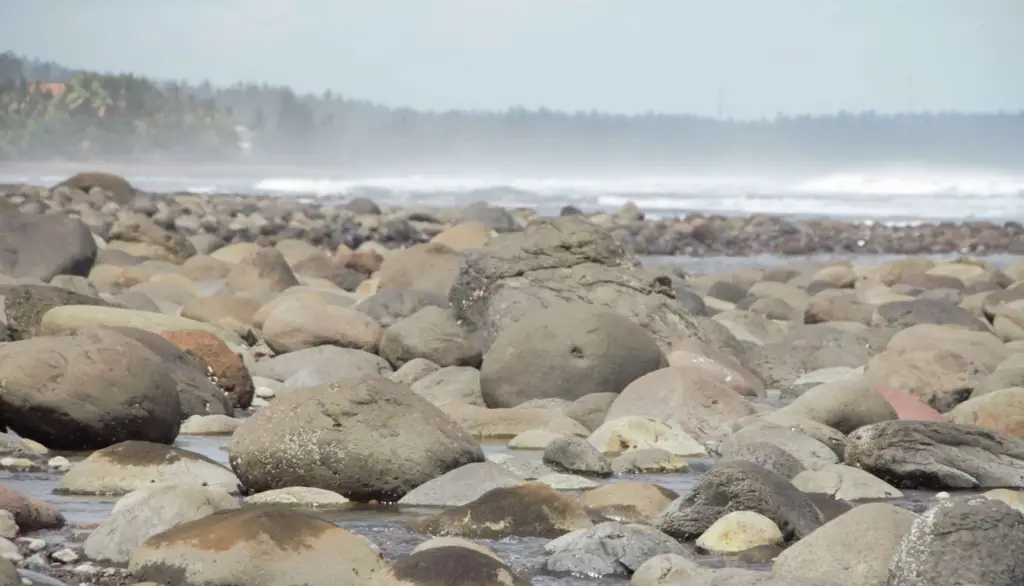
The second in our 7 days in Bali itinerary, after a hearty breakfast, was Yeh Leh Beach or Pantai Yeh Leh as the locals call it. This beach was about 2 hours drive from our hotel along the Denpasar-Gilimanuk Highway and is known for two unique features.
The first thing we noticed was the many boulders scattered along the beach. No one knows why or how these rocks came here. Some of these rocks are covered in algae while some have been smoothed by the waves over the years, leaving fewer clues to their origin.
On the eastern end of the beach is a beautiful black sand beach. However, the waves were so high that swimming here was out of the question. We spent some time at the gazebo, simply relaxing and taking in the beautiful sea before making our way to our next destination.
There is no entrance fee to visit this beach and because it is secluded, there aren’t many people here. There are no stalls or restaurants here, so if you plan to stay longer, bring your food and beverages.
Pura Batu Bolong

The third in our 7 days in Bali itinerary was Pura Batu Bolong which is next to Pura Tanah Lot Temple. This temple is about an hour from Yeh Leh Beach and is oriented towards Mount Agung.
This temple is often overlooked by tourists when compared to the Tanah Lot temple. Pura Batu Bolong is another place to enjoy the sunset. The temple sits on a black coral rock which is the same rock as the Tanah Lot temple.
As the temple is always used for Balinese religious rituals, the doors to the temple are closed to the public who can only view the temple from the outside.
Tanah Lot
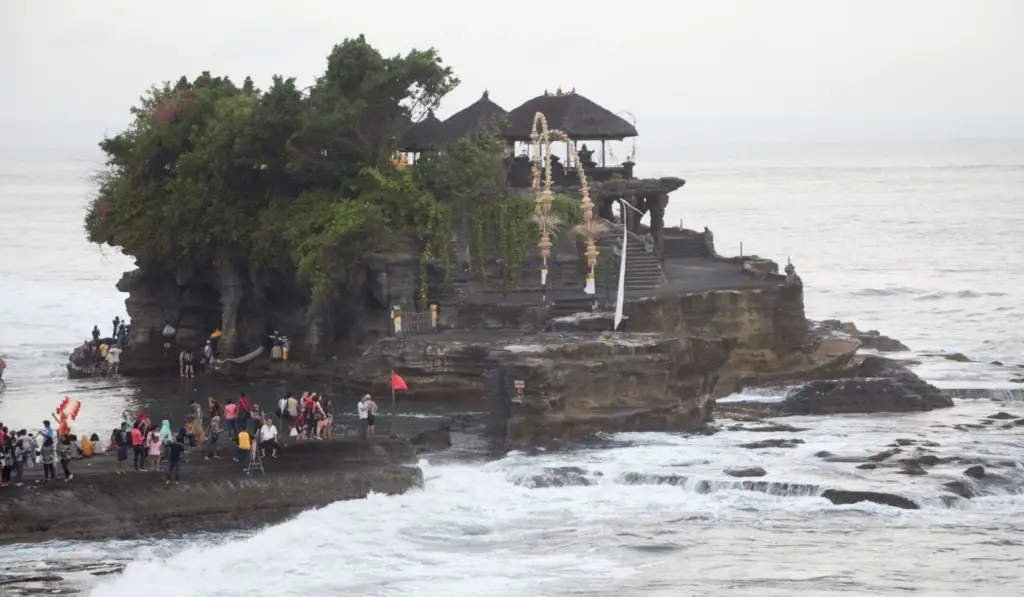
The fourth in our 7 days in Bali itinerary was the Tanah Lot temple. This iconic temple means “land in the sea” and is located about 12 miles northwest of Denpasar. This 16th-century temple was built by a priest named Dang Hyang Nirartha who meditated on the rocky outcrop.
The main deity of the temple is Dewa Baruna who is the God of the Sea in Balinese Hinduism. This temple is one of the seven sea temples along the coast of Bali that is believed to protect the island from calamities.
When we arrived, it was almost sunset and the crowd had swelled with many people still trying to get into the main temple which had already closed. We stood on higher ground as we watched the high tide coming in.
The waves were high and the currents were strong. We managed to get our sunset photo and made our way to the exit.
While sunset is the best time to visit the temple, we advise that you come there at least 2 hours earlier to get a good spot to take a photo. There is an entrance fee of Rp75,000 ($5) for adults and Rp30,000 ($2) for children.
Day 3: Batuan Temple, Goa Gajah, Candi Tebing Gunung Kawi, Pura Tirta Empul
Batuan Temple
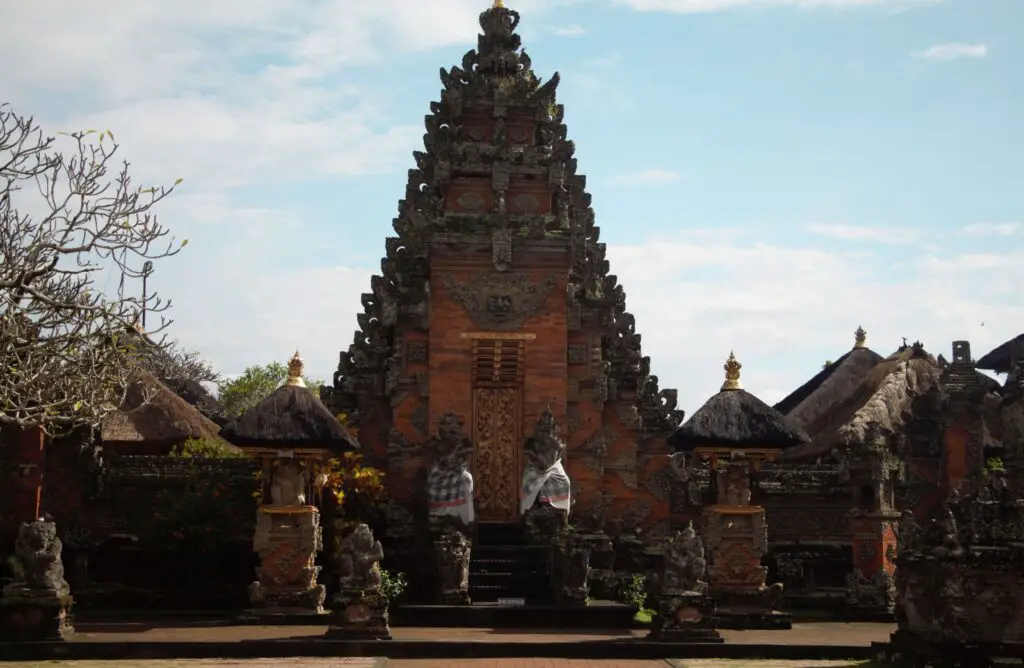
The fifth in our 7 days in Bali itinerary is Batuan Temple of Pura Puseh Batuan which is about an hour from Kuta. This temple is south of Ubud and is one of the oldest and most sacred temples in Bali.
What stood out when we arrived was the intricate carvings and traditional Balinese architecture of the temples and pavilions within the complex. As a mark of respect, we were required to wear a sarong and sash which can be obtained from the ticket office and is included in the ticket price.
The entrance gate or Candi Bentar is made from red bricks and heavily decorated with floral designs. The unique feature is that the Gate Guardian or Dwarapala statues are standing and are not holding any weapons.
This is unlike other temples where the guardians are in a sitting position with weapons in their hands. Once you enter Candi Bentar, we came to the actual entrance, Kori Agung. This is the entrance of the gods as the Balinese Hindus believe.
As this is an active temple, there is a mandatory dress code that requires visitors to cover their chest and knees. While the temple is open 24 hours a day for the locals to worship the deities, the opening hours for visitors are from 9 am to 6 pm daily.
The earliest written record of the temple mentions that it was built in 1020 AD and is part of the ‘Tri Kayangan’ or the ‘Trimurti’ concept. This means you can worship Lord Brahma, Lord Vishnu, and Lord Shiva within the complex. The entrance fee is Rp30,000 ($2), including the sarong, sash, and parking fees.
After spending an hour here, we made our way to our next destination, Goa Gajah.
Goa Gajah
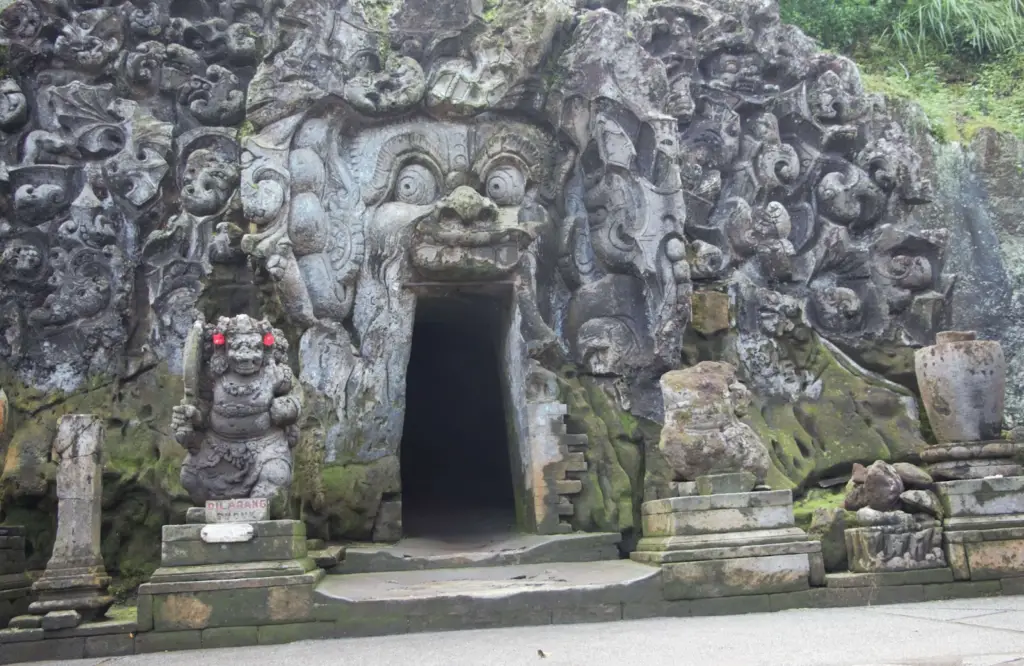
The sixth in our 7 days in Bali itinerary is Goa Gajah or Elephant Cave. This cave is about an hour from Batuan Temple and within Ubud. This cave is a 15-minute drive from the center of Ubud.
To get to the entrance to the cave, we walked down a flight of stairs. As this is an active worship site, a proper dress code is necessary. This means that you have to cover your shoulders and knees. Sarongs are available on loan near the ticketing booth.
While no one knows the origins of the temple, the site is believed to be dated to the 11th century. As we walked towards the entrance, the menacing face which is said to ward off evil.
We were plunged into complete darkness as we ventured into the cave. With no artificial lighting, we relied on the light from our handphones. Once inside, there are two small passageways.
The narrow passageway on the left led to a small niche with a statue of Lord Ganesh while the right passage contained lingams and yoni to honor Lord Shiva. Inside, the cave is extremely small and gets easily crowded.
We continued walking around the courtyard and saw a bathing pool with statues adorning the walls. Our guide told us that these statues represented the seven holy rivers in India, namely, Ganga, Yamuna, Sarasvati, Godavari, Sindhu, Kaveri, and Narmada rivers. There is an entrance fee of Rp50,000 ($3.35) for adults and Rp30,000 ($2) for children with the opening hours from 8 am to 5 pm daily.
Candi Tebing Gunung Kawi
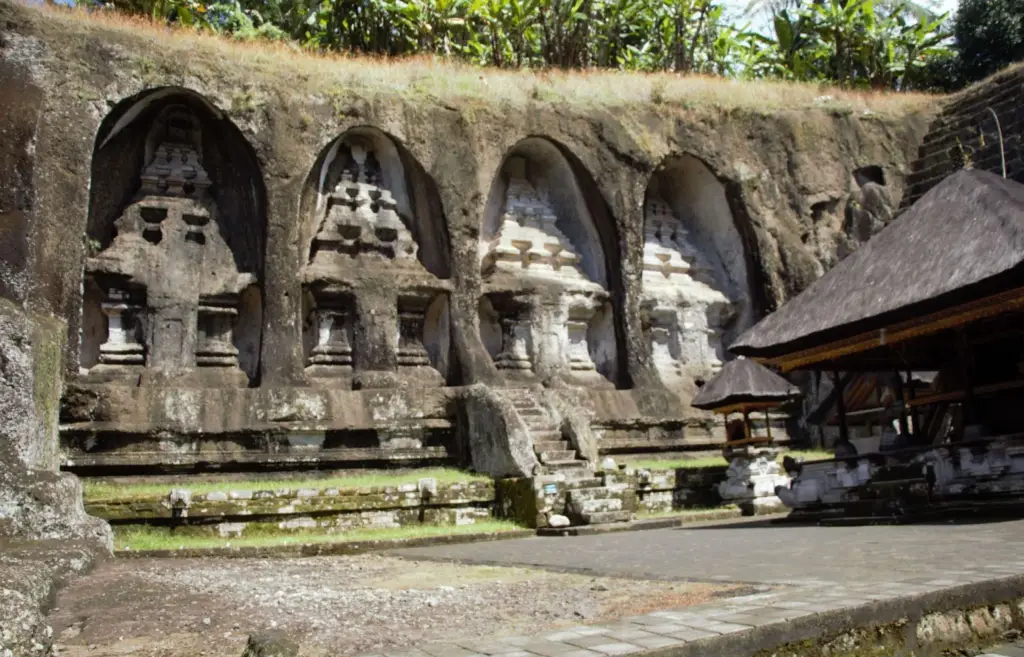
The seventh in our 7 days in Bali itinerary was Candi Tebing Gunung Kawi. This 11th-century temple and funerary complex are located in Tampaksiring which is a 20-minute drive from Goa Gajah.
We paid an entrance fee of Rp50,000 ($3.35) which includes the use of a sarong if required. As we walked down the stairs toward the funerary complex, the stairs were lined with stalls selling drinks and souvenirs. There are only one entry and exit stairs to this complex.
At the end of the stairs, we proceeded to a stone archway with held earthen vases filled with holy water. We sprinkled the holy water on ourselves which symbolically meant purifying ourselves before entering the grounds of the complex.
We reached the five shrines that were believed to be for King Udayana, his Queen Mahendradatta, and their two sons. The Pekerisan River which flows through Tirta Empul also flows through this area.
Within minutes we reached the first set of the rock-cut candi. The first set had 5 carved niches which were dedicated to King Udayana, Queen Mahendradatta, and their two sons.
After crossing the bridge, we reached the four other shrines which were dedicated to the king’s minor queens and concubines.
Our guide explained that while the origin of these tombs was unknown, except for an eligible inscription that states that “a king built these temples”, no one knows who or which king built them.
Hidden in the valley, we spotted several meditation caves where monks could have come to meditate. After spending an hour here, we made our way back to the only stairs which led us back to the parking area.
Tirta Empul
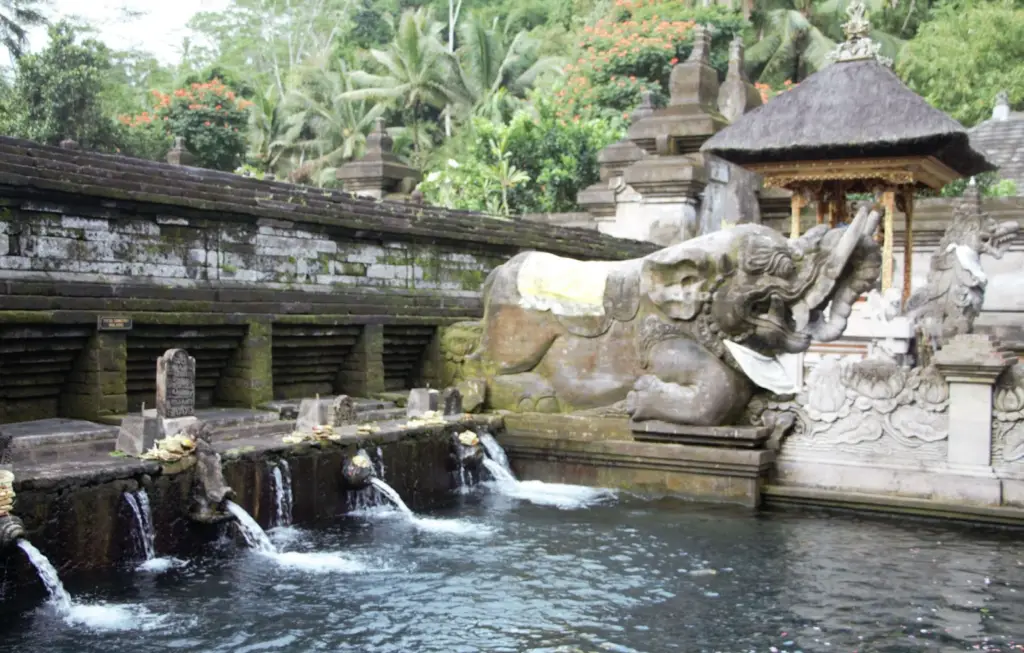
The eighth in our 7 days in Bali itinerary was Tirta Empul. This temple is a 5-minute drive from Pura Gunung Kawi. When we arrived, the place was already crowded with both locals and tourists.
We paid an entrance fee of Rp50,000 ($3.35) for foreigners which includes a sarong that is to be worn throughout the complex. The name Tirta Empul in Balinese means “holy spring water”.
The spring and temple complex was built in 962 AD during the Warmadewa Dynasty and is dedicated to Lord Vishnu. The main area where the bathing takes place is known as “Jaba Tengah” which is the inner courtyard where the bathing ritual takes place.
Although we didn’t participate in the bathing ritual, there was already a long line. Our guide explained that the ritual was known as melukat which is a spiritual experience for non-Balinese.
The process sees the bathers queueing in line beginning on the left side under the first spout. They continue until they have cleansed themselves under each of the water spouts.
Bathers do not bathe under the last two water spouts are meant for cleansing the dead and are not to be used by the living under the melukat ritual.
Behind the purification pool, there is a large courtyard that has a large water spring known as jeroan. As we walked into the inner courtyard, we appreciated that it was not as busy as the main pool area, and this gave us some time to relax and admire the beautiful surroundings.
You can join the Tirta Empul temple tour with an optional spiritual cleansing or take the full-day spiritual cleansing and shamanic healing tour where you experience healing by raising your vibrations with mantras. You can opt to end your day with some kopi luwak.
Day 4: Abandoned Planes, Dreamland Beach, Beachwalk Shopping Complex
Abandoned Plane 1

The ninth in our 7 days in Bali itinerary was our first abandoned plane. This former Sriwijaya Air is a Boeing 737 with a registration number PK-CKM. When we visited, the aircraft was lying abandoned. We could just walk in and explore the grounds.
Although there was no entrance fee, we didn’t spend long there as the bushes and shrubs made walking to the plane uncomfortable. Plus, the plane itself didn’t look safe. Hence, we didn’t want to take the risk of getting injured.
Then again, our 7 days in Bali itinerary happened in 2017 and a lot has changed since then. The plane is now completely refurbished and is a tourist attraction named AirCrew Sensation Bali where you can experience being a pilot for a day.
The plane is complete with a cockpit simulator with friendly staff with an experienced pilot as a flight instructor. There is a coffee shop nearby with excellent customer service. It looks like we need another trip to Bali, soon.
Abandoned Plane 2
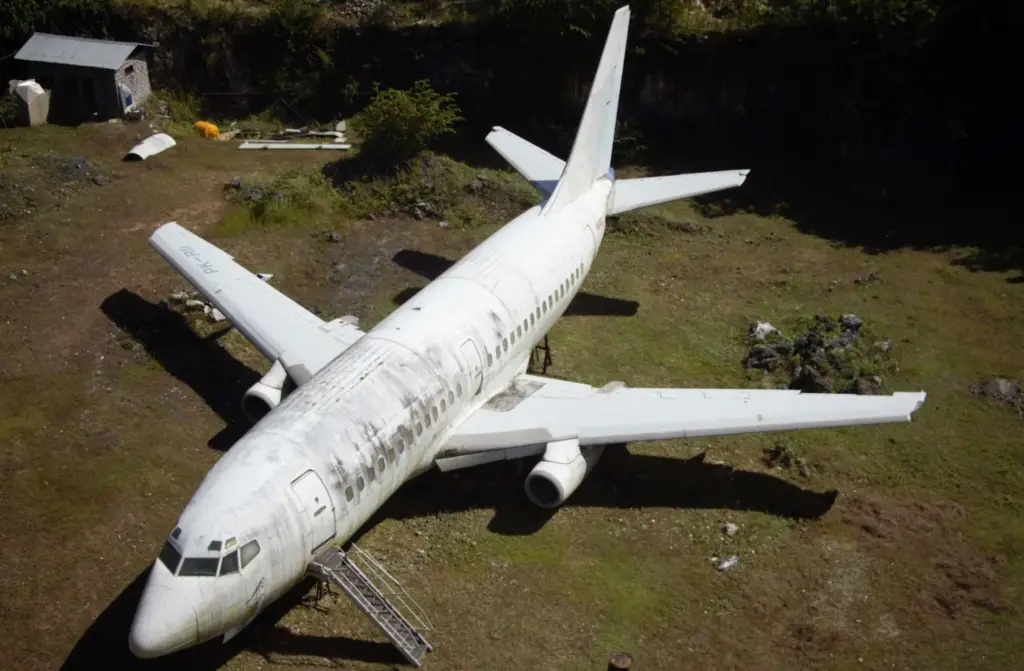
The tenth in our 7 days in Bali itinerary was our second abandoned plane which was a Boeing 737-200 at Bukit Peninsula along Jalan Nusa Dua Selatan. This plane was located very near Pandawa Beach.
When we reached the entrance to the viewpoint, there was a guard who initially didn’t let us through. After conversing with our guide, we paid the entrance fee to walk up to the viewpoint. Since we were the only ones there, we had all the time to explore the area.
There was a short hike to reach the viewpoint and at the top, we reached a fenced area and this was what we saw. While admiring the stunning abandoned plane, be careful of the steep cliff and sharp edges.
As this was on private property, we could not access the grounds where the aircraft was. This aircraft was formerly a Mandala Jet Airlines with a registration PK-RII before being further rebranded as Tigerair Mandala.
The plane was moved to this quarry in 2013 and rumours are that it was supposed to be turned into a tourist attraction. However, unlike the other abandoned plane which was successfully converted into a tourist attraction, we do not know what happened to this aircraft.
Dreamland Beach

The eleventh in our 7 days in Bali itinerary was Dreamland Beach. This beautiful white sandy beach is a “hidden” beach in that it is secluded by the limestone cliffs and rugged coastline of Bukit Peninsula.
We arrived here at noon and there were some deck chairs and parasols available for rent. While the locals refer to this beach as Cimongka, the name Dreamland Beach as it is a popular spot for surfers.
Beach peddlers offering cold drinks were roaming the beach as we looked for a restaurant that served Indonesian and Western cuisine. This beach is close to Uluwatu where you can combine a visit to both places in one day. We didn’t visit Uluwatu on this trip as we planned for our next trip to Bali.
After taking many photos, it was time for lunch and we decided to head back to our hotel in Kuta.
Beachwalk Shopping Complex
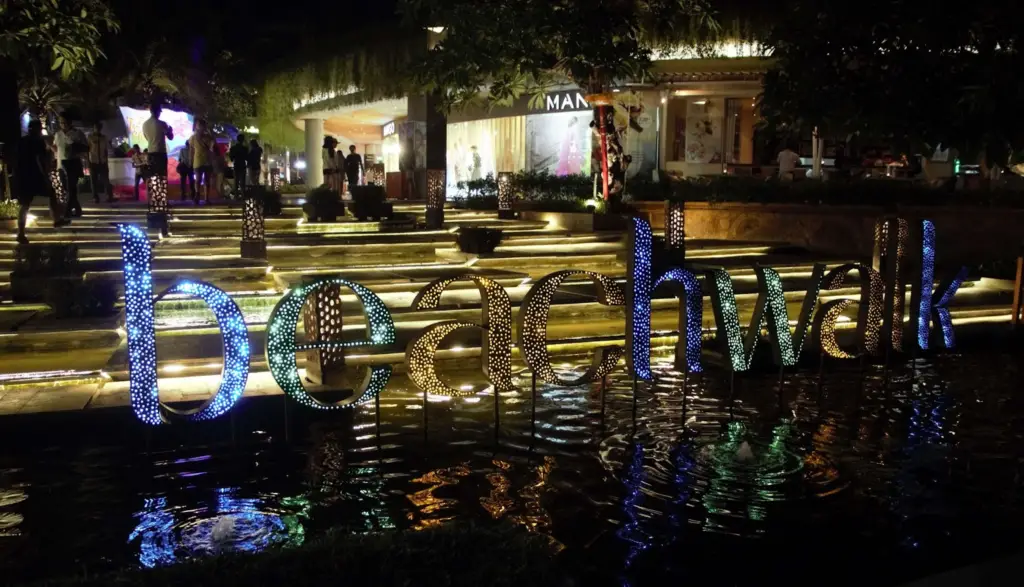
On the twelfth of our 7 days in Bali itinerary were spending our time at the Beachwalk Shopping Center. This shopping complex was a quick 2-minute walk from our hotel. This large and modern shopping complex has many local and international brands.
What we found unique was the architecture that resembled the paddy field terraces of Bali complete with large ponds and running water features across all levels. The third floor is also one of the best places to view the stunning Balinese sunset. We had our dinner at Johhny Rockets and got some dessert at Cold Stone Creamery and called it a day.
Day 5: Pura Ulun Danu Bratan, Wanagiri Hidden Hill, Pura Ulun Danu Tamblingan, Lovina Beach
Pura Ulun Danu Bratan
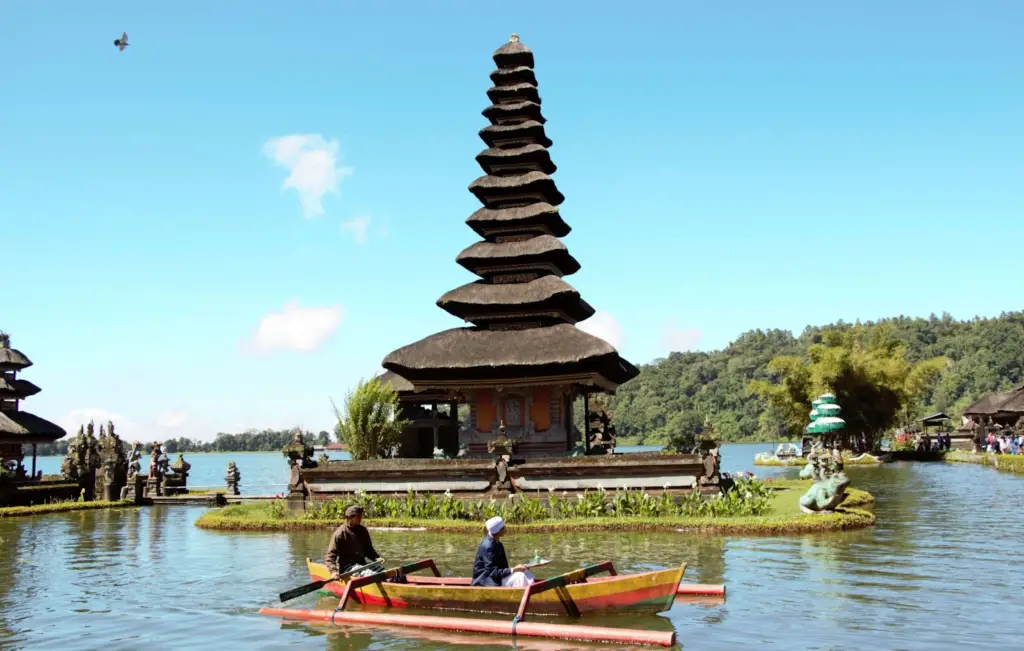
The thirteenth of our 7 days in Bali itinerary began with Pura Ulun Danu Bratan which was approximately 2 hours from our hotel. This Shaivite temple is on the shores of Lake Bratan. This is a living temple as the locals come here to pray to the water, lake, and river Goddess, Dewi Danu.
We paid an entrance fee of Rp 75,000 ($5) for foreigners and arrived at the temple by 9 am. The best time to visit the temple is in the morning between 9 am to 11 am.
The photo above is the Lingga Petak or as the locals call it, Meru Tumpang Solas temple faces south and is dedicated to Lord Vishnu and Goddess Dewi Dhanu. The temple has four days which represents the four cardinal directions.
After taking photos here, we walked to the Penataran Agung which was built to honor the Tri Purush Shiva which is Shiva, Sadha Shiva, and Parama Shiva. The other place which you can’t miss is the Buddhist stupa that signifies religious harmony. By 11 am, we had thoroughly explored the place and were glad to leave as busloads of tourists had just arrived.
Wanagiri Hidden Hill
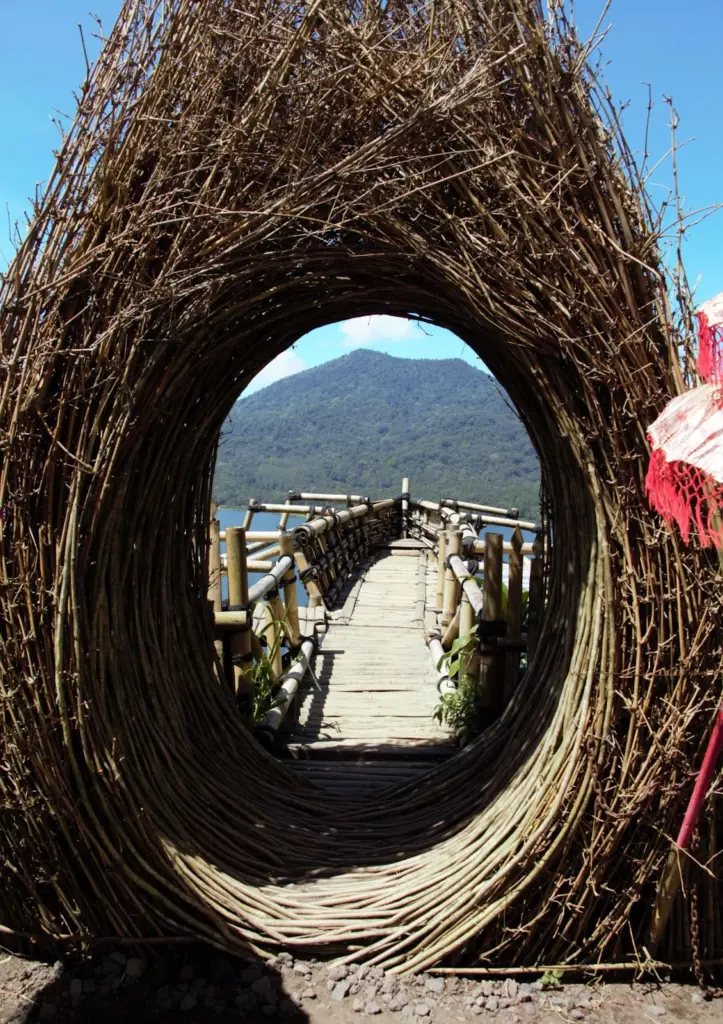
The fourteenth in our 7 days in Bali itinerary was Wanagiri Hidden Hill which was a quick 20-minute drive from Pura Ulun Danu Bratan. This is a popular Instagrammable selfie spot for locals and tourists. There is an entrance fee between Rp100,000 ($7) to Rp150,000 ($10) per person.
Wanagiri Hidden Hills are open from 8 am to 6 pm and are known for its unique bamboo structures such as the bow of a boat, a beautiful human-sized bird’s nest, wooden teacups, and much more.
All these structures face either Lake Buyan or Lake Tamblingan with lush green mountains in the background. One of Bali’s famous swings is also located here.
When we arrived here, there were already people lined up to take photos of the various bamboo structures. After taking a few photos, we moved on to our next destination which was our highlight for the day.
Pura Ulun Danu Tamblingan
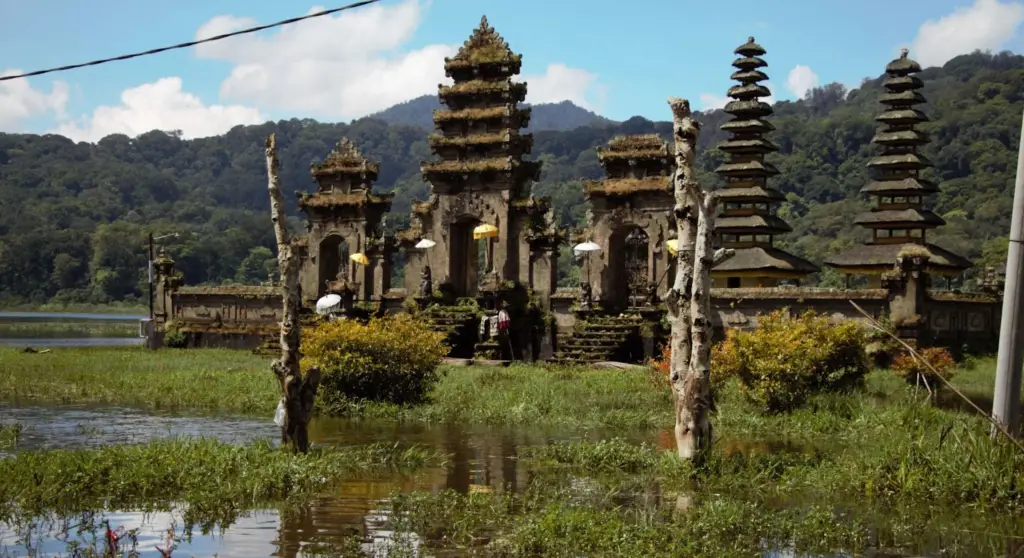
The fifteenth in our 7 days in Bali itinerary was Pura Ulun Danu Tamblingan which is on the shore of Lake Tamblingan. Now, this temple wasn’t in our initial itinerary and it was our guide who suggested a visit here.
This beautiful temple was a 15-minute drive from Wanagiri Hidden Hill. When we arrived, a local family had just finished their prayers. To us, this was our highlight for the air. Imagine being surrounded by green hills and breathing fresh air.
Since this temple is off the beaten path, there were no tourists here, other than another couple besides us. Our guide explained that this temple was unique in that it had two Meru shrines. One was for the local villagers while the other was for the people of Buleleng.
A boat ride could set you back by Rp150,000 ($10) while there is an entrance fee of Rp 100,000 ($7) per person to visit the temple. The best time to visit the temple is just before sunrise and not mid-afternoon which we went to.
After taking a few photos, we moved to our last destination for the day, Lovina Beach.
Lovina Beach
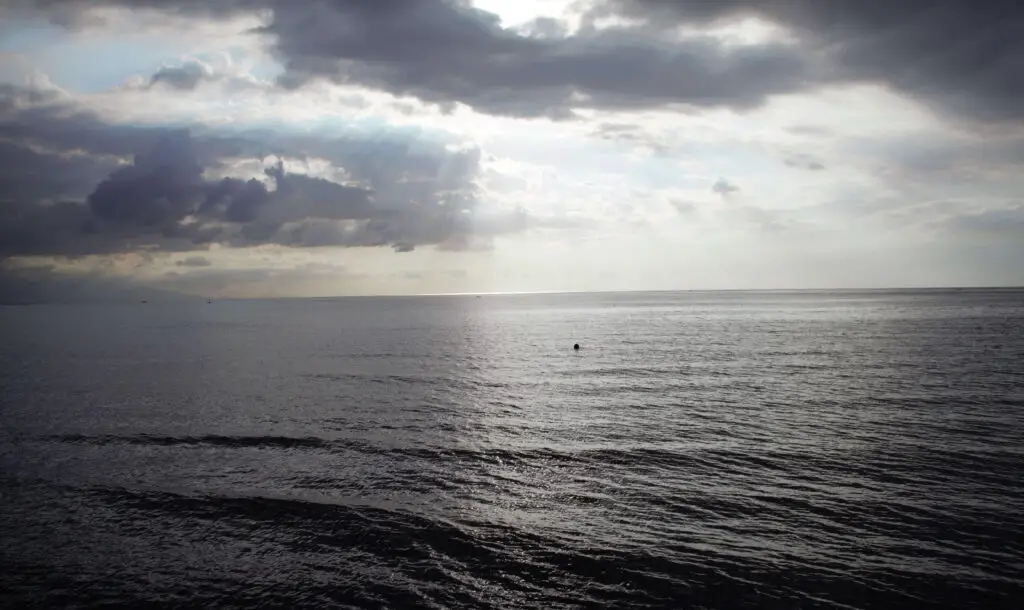
The sixteenth in our 7 days in Bali itinerary was Lovina Beach. This beach is a 45-minute drive from Pura Ulun Danu Tamblingan and as you can see, we reached it just before sunset.
The beach is famous for its black volcanic sand beach and as a playground for the bottle-nosed dolphins that swim along the northern coast of the island. The name Lovina is credited to Pandji Tisna who is considered the pioneer of Balinese tourism, especially in the northern areas.
The name Lovina is a combination of the words Love Indonesia. Since there was nothing we could do here, the souvenir stalls and shops had all closed, we just admired our beautiful sunset. We left for our hotel right after sunset, exhausted and grateful for a day well spent.
Day 6: Pura Besakih

The seventeenth in our 7 days in Bali itinerary was Pura Besakih, a 2-hour drive from our hotel in Kuta. Besakih is the largest and holiest temple in Balinese Hinduism as it is believed that this temple is the essence of Tri Hita Kirana.
Tri Hita Kirana means that life on earth must be lived and kept in a harmonious balance between Man and God, man and society, and man and his environment. Pura Besakih is located 1,000 meters on the southwestern slope of Mount Agung.
While no one knows its exact origins, a central stone indicates that the temple was a holy site since ancient times. The temples that resemble a stepped pyramid date back to at least 2,000 years ago.
When we arrived, there was already a steady stream of locals with their prayer offerings. While the temple is open 24 hours a day for locals, the visiting hours for tourists are from 8 am to 5 pm daily.
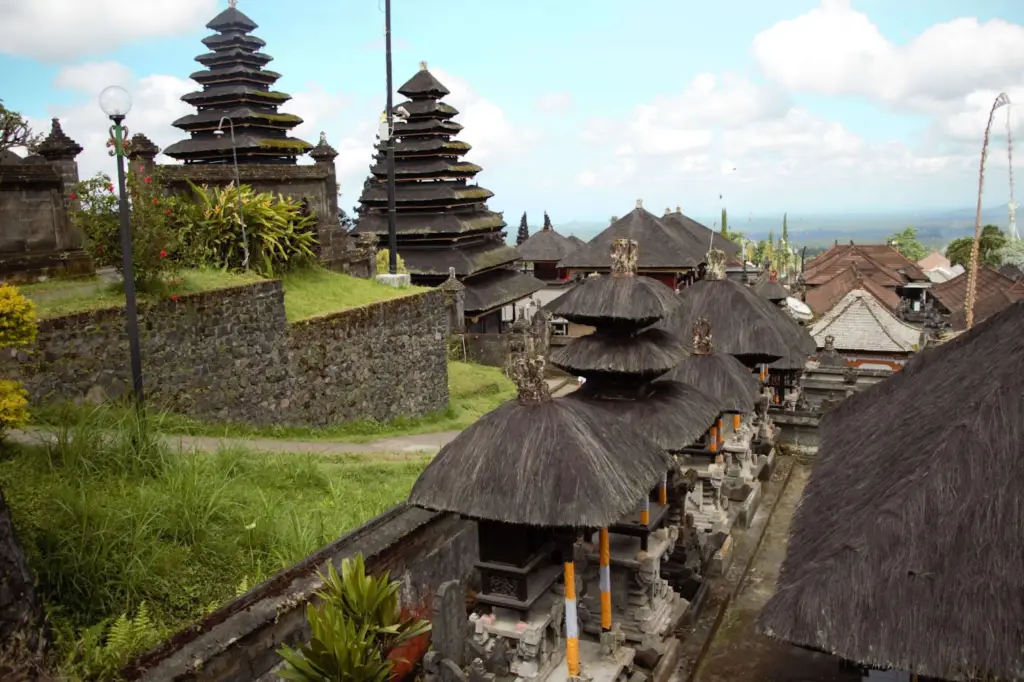
At the ticket counter, we paid an entrance fee of Rp 60,000 ($4) for foreign adults and Rp 30,000 ($2) for foreign children. The entrance fee includes a sarong which is to be worn at all times since this is a living temple.
After tying our sarongs, we walked towards the main Candi Bentar, we walked up towards the main shrine, Pura Penataran Agung which is also the largest temple in the complex.
The temple is a collection of at least 86 clan temples and 23 ancient temples with the three major temples dedicated to the Hindu Gods of Lord Brahma, Lord Vishnu, and Lord Shiva. There are stairs and a pathway that leads to the various temples.
And, we noticed that it was a pilgrimage for the locals that seemed mystical against the backdrop of Mount Agung. The temples are divided by status, class, and function. Although we could visit the inner temples, there were many prayers ongoing inside the courtyard.
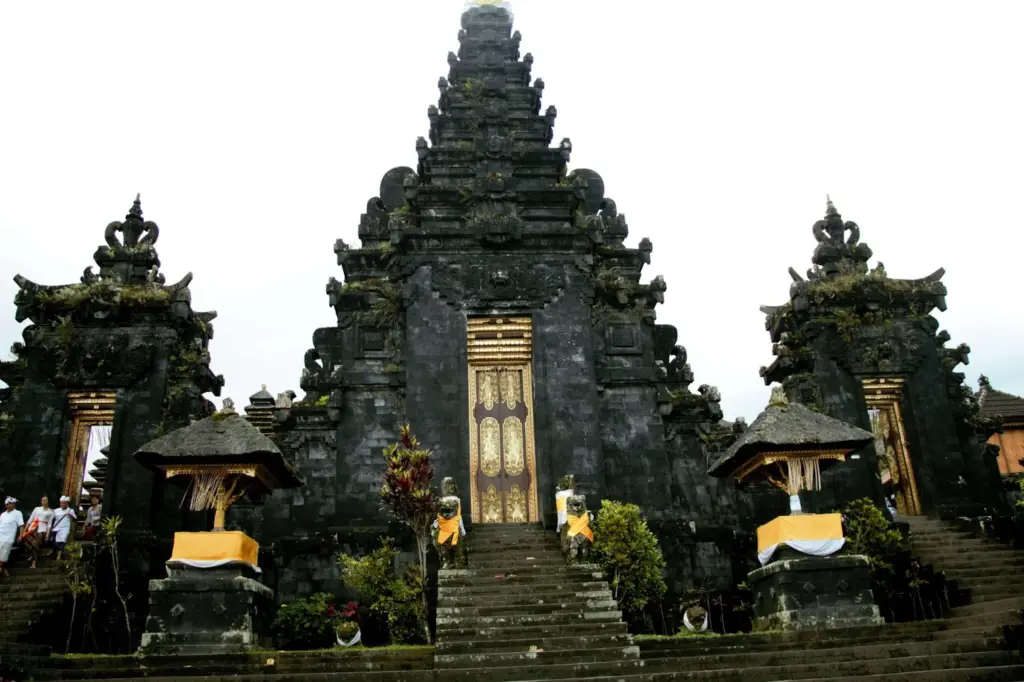
The closest temple to Mount Agung is Pura Pangubengan which is the best post to take panoramic vistas of the temple and its surroundings. A 30-minute walk will take you to Pura Batu Tirta which is the source of the holy water used in the various rituals.
Four major temples represent the cardinal directions and the deities governing each sector. For example, in the north is Pura Batu Madeg which also houses the central stone while Pura Kiduling Kreteg represents the south.
Pura Gelap represents the east while Pura Ulun Kulkul represents the west. These are some things to know that we learned to make your trip worthwhile:
- With self-professed ‘temple guards’ and touts, Besakih is a tourist trap. You are required to dress decently at all times and this means, no exposed knees or shoulders.
- You can hire official guides that are dressed in symmetrical batik-patterned shirts although their services are reasonable, considering how big the place is. Your local guide can follow and explain to you as our guide had prayed here before.
- Women who are having their menstrual cycles are not allowed to enter the premises as they are considered impure. This is related to the fact that there are Hindu texts that associate having menses with being impure.
- The best time to visit Besakih is in the morning when the crowds have not arrived yet, preferably before 10 am. This gives you enough time to explore the area in your own time and place.
- Foreigners are allowed to conduct prayers here. However, you must be dressed in white. The offerings can be purchased at the many stalls outside the temple complex.
Since this was our only agenda for the day, we left for Kuta after spending almost 4 hours here.
Day 7: Tirta Gangga & Keramas Aeropark
Tirta Gangga
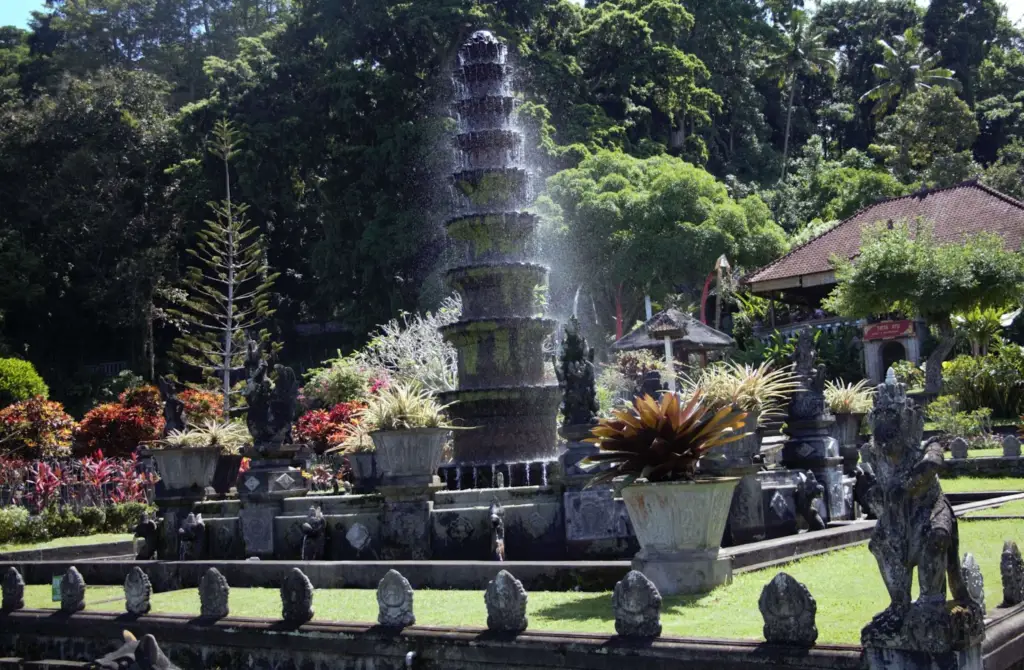
The eighteenth in our 7 days in Bali itinerary was Tirta Gangga which was about 2 hours from our hotel. This beautiful water palace was named after the Ganges River in India for its sacred water.
Here, the water is sacred in that it is vital for irrigation and agricultural abundance, recreation, and economic activities. As this park is popular with both locals and tourists, you can expect a large crowd whenever you visit.
It was almost afternoon by the time we reached and the lush greenery was calming. We paid an entrance fee of Rp50,000 ($3.40) for adults while. If you want to swim in any of the pools, the rate is Rp20,000 ($1.35) per person.
We paid Rp5,000 ($0.30) to feed the koi fish in the ponds as we walked along the well-manicured gardens. The park is open daily from 8 am to 11 pm, except on Nyepi when it is closed.
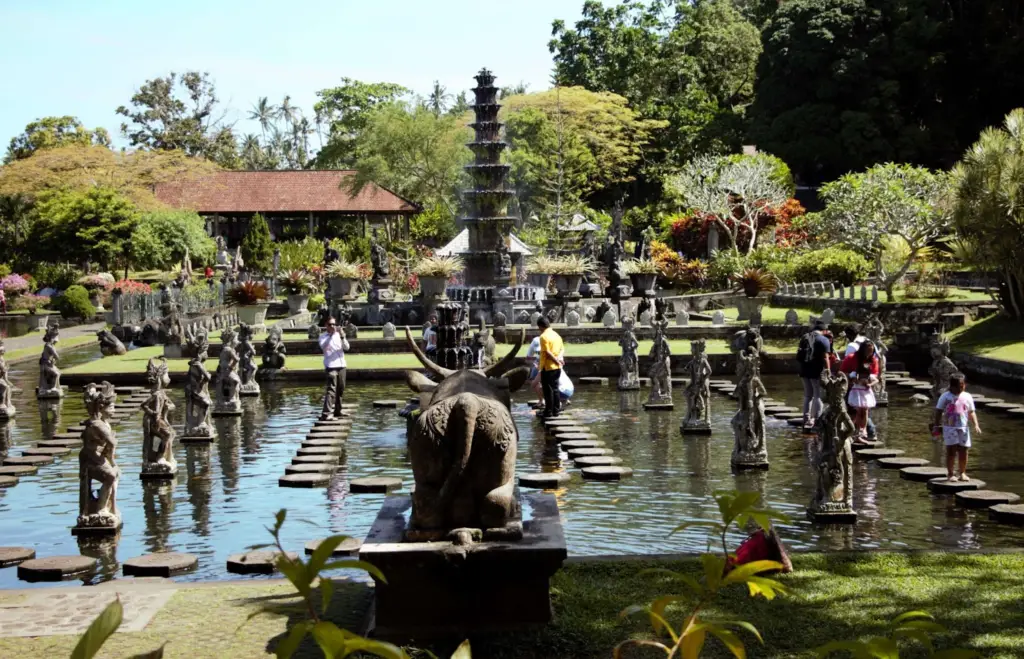
As we entered, we noticed the two ponds. The pond on the left served as a wading pool and is one of the pools where swimming is allowed. The pond on the left is filled with koi fishes and has stepping stones that you can walk on to get closer to feed the fish.
Behind the pond is a central fountain with guardian statues at its base. We continued walking towards the higher ground where the natural springs are located. The natural spring is under a Banyan Tree and is used by the locals for religious purposes.
We continued to the restaurant where we had our lunch at Tirta Ayu Hotel and Restaurant which is located within the premises of Tirta Gangga. After a hearty lunch, we made our way to the next and final destination of our 7 days in Bali itinerary.
Keramas Aero Park

The nineteenth and last in our 7 days in Bali itinerary was Keramas Aero Park. While many of us associate planes with flying, Keramas Aero Park successfully converted an abandoned plane into a restaurant complete with opportunities to explore the cockpit and wings.
Keramas Aero Park is at Keramas Beach, approximately 1.5 hours from Tirta Gangga. The easiest and fastest way to get here is by car or hiring a driver to get you there. When we arrived, our guide explained that this was the only plane that was successfully converted from an abandoned plane.
This is a Boeing 737-400 and while the restaurant is in the cabin of the plane, there is a bar beneath the aircraft. Since we were not hungry, we decided to explore the grounds instead.
There are several seating areas with the first being the landscaped gardens which are suitable for kids who love to run and play. However, that area is exposed to the elements. The second is the bar that is beneath the aircraft. This area is cool and lively.
The third seating area is inside the cabin itself, which has limited seating. The inflight menu is a combination of Indonesian, Western, and Italian. Sandwiches and burgers are also available. There is a separate kid’s menu which includes a ham and cheese sandwich and honey-glazed chicken wings.
After walking around a little bit more, we headed back to our hotel to rest and relax. We were grateful that our trip was full of memories that we would cherish. We told ourselves that we would return to Bali, simply because we can never get enough of it.
What are the best places to stay in Bali?
Amankila

Amankila is a 34-suite luxury resort in Eastern Bali that overlooks the Lombok Straights. What we love about this resort is its breathtaking views of the ocean and landscape. The resort features landscaped gardens, a three-tiered swimming pool, and a private beach.
All rooms are spacious and designed with elegance in mind, incorporating traditional Balinese furnishings that add to the charm of the resort.
While there are mostly positive reviews of this resort, the resort is isolated which makes it difficult for guests to explore the surrounding areas. Also, as this is a luxury resort, the high room rates may not be affordable to all travelers.
However, the stunning location makes this resort perfect for a peaceful retreat. This luxurious resort remains a popular accommodation of choice for those seeking a high-end vacation experience.
Kamandalu

Kamandalu is a 58-suite luxury villa in the heart of Ubud. What makes this resort unique is its location in the lush tropical forests which gives it a peaceful and serene vibe. The staff is friendly, and attentive, and always seeks to provide guests with a comfortable stay.
Due to the resort being in a forest, guests have reported that insects and other wildlife can enter the rooms and this can be an unpleasant experience for some. The resort is outside the main town of Ubud which means that it is difficult to explore the area without transportation.
Viceroy

Our third resort of choice for the best places to stay in Bali is one of the best places to stay in Ubud is Viceroy. With stunning views of the rainforests and exceptional service, staying here would leave you with beautiful memories of Bali.
While the resort is known for its luxurious details, and friendly and accommodating staff who make every effort to ensure that guests have a comfortable stay, the resort is remote which makes it difficult to explore the surrounding areas.
The resort is expensive and may not be within everyone’s budget. However, if you plan to splurge, this is the place to be. With a beautiful infinity pool, a spa, and a picturesque location, this resort ticks all the boxes for a peaceful, calming, and relaxing holiday.
W Bali

This 237-room luxury beach resort in Seminyak is known for its excellent location on the beach and is close to many restaurants, shops, and attractions within Seminyak. This is W Bali. The plus point of the resort is its beautiful, modern, and stylish rooms.
The staff is also friendly and helpful while providing services that go above and beyond their assigned duties. What we loved was the fact that the resort catered to both high-end guests and casual options in their dining experience.
With W being a popular brand, the resort can be busy and crowded, making it difficult to find a quiet place to relax and enjoy the hotel’s facilities and amenities. The large number of guests also means that the cleanliness may not be at par always.
As it is in a strategic location, the resort is noisy, especially during peak tourist season as parties and events are held. Overall, W Seminyak is suitable for those seeking vibrant surroundings and lively nightlife.
Ayana Resort

Ayana Bali is a 294-room resort hotel in Jimbaran and is famous for its stunning location on cliffs that overlook the Indian Ocean. The resort has several restaurants and bars. However, it is its spacious and well-appointed rooms decked in traditional Balinese decor make this resort unique.
The resort offers a wide range of activities with several swimming pools and an infinity pool that overlooks the ocean. While the resort can get crowded during peak season, navigating the resort becomes difficult as it is large.
However, if you are looking for a luxurious getaway with Instagrammable views, Ayana Bali is for you. The excellent service, range of amenities, and stunning views make this resort a popular choice for tourists seeking luxury at its best.
Frequently Asked Questions on Bali
Bali is famous for its beautiful beaches, friendly people, and stunning landscapes. The island remains a popular tourist destination. From the temples of Uluwatu, Tanah Lot, and Besakih to its lush rice terraces, Bali is a unique blend of nature, adventure, and relaxation.
The best months to go to Bali are during the dry season from April to October. The wet season is from November to March which sees heavy rainfall, especially in January. The months which see fewer crowds are January, February, and October.
No, Bali is not part of Malaysia. Bali is the only Hindu-majority island in Indonesia that lies between Lombok to its east and Java to its west. The province of Bali constitutes smaller islands such as Nusa Penida, Nusa Lembongan, and Nusa Ceningan.
No, they do not speak Malay in Bali. Bahasa Indonesia is the official language of Indonesia. This language is a variation from the standard Malay spoken in Malaysia and Singapore. However, you can get along just fine with basic knowledge of Malay. This is because Malay is the universal language of Indonesia, Malaysia, Singapore, Brunei, and Southern Thailand.
The cheapest months to visit Bali is from October to March which falls during the wet season and off-peak season. During these months, accommodation is cheaper. Although hiking, swimming, and surfing are not advisable during these months, you can always opt for a relaxing holiday among the green rice terraces of Ubud.
Hello in Balinese is Om Suastiastu which means “peace and greetings from God”. A formal Indonesian greeting would be Selamat Pagi or Selamat Siang which means “good morning”.
Thank you in Balinese is Suksma or in Bahasa Indonesia, you can say, Terima Kasih. The literal translation of terima kasih is to “accept with love” as “Terima” means accept and “kasih” means love.
The main religion in Bali is Balinese Hinduism or Agama Hindu Dharma. This distinct form of Hinduism is only found in Bali and it incorporates animism and ancestor worship. Hinduism reached the Indonesian Archipelago in the 1st century with the versions of the Mahabharat mirroring those found in Tamil Nadu, India.
There are several ways where you can be respectful in Bali. Firstly, always dress appropriately, especially when visiting temples or religious sites. Always cover your shoulders and knees and avoid revealing clothes.
Secondly, always remove your shoes before entering a temple or a Balinese home. It is customary to remove shoes. Hence, always look out for signs indicating where your shoes should be kept. In some places, indoor shoes are provided.
Thirdly, always use your right hand, especially when giving or receiving something and when shaking hands. Finally, always respect local customs whether it is removing one’s shoes or remaining quiet during religious ceremonies.
The coldest places in Bali are Bedugul, Ubud, Batukaru, and Sidemen which are in the highlands of north Bali. These areas are within the mountains which receive may rainfall than lower coastal areas.
Yes, Bali is worth visiting! From its beautiful beaches, rich culture, and delicious food, Bali has something for everyone.
While some popular attractions include Uluwatu Cliff Temple, Tanah Lot Temple, and the Tegalalang Rice Terraces, Bali is also known for its world-class surfing experience. If you are looking for a mix of adventure, relaxation, history, and authentic culture, Bali is the perfect destination.
7 Days in Bali Itinerary for the Ultimate Island Adventure Read More »
